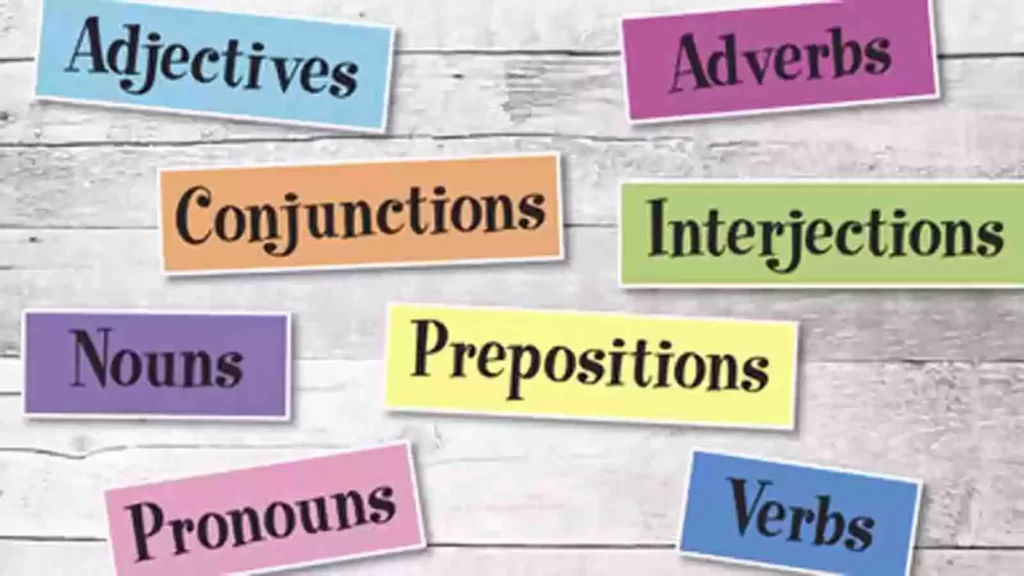Parts of speech : Examples and Rules | English Grammar

Sentence के प्रयोग के अनुसार शब्दों (Words) को भिन्न-भिन्न भागों में विभाजित किया जाता है। इन्हें शब्द-भेद (Parts of Speech) कहते हैं।
Parts of Speech आठ प्रकार के होते हैं
- Noun (संज्ञा)
- Pronoun (सर्वनाम)
- Adjective (विशेषण)
- Verb (क्रिया)
- Adverb (क्रिया-विशेषण)
- Preposition (सम्बन्धसूचक शब्द)
- Conjunction (Connector-संयोजक)
- Interjection (विस्मयसूचक शब्द)
1. Noun (संज्ञा)
किसी person, things या place को प्रकट करने वाले शब्द को Noun कहते हैं।
A Noun is a word used as the name of a person, place or thing.
जैसे :-
Chandragupta was a great king.
The rose smells sweet.
Gold is yellow.
उपरोक्त वाक्यों में Chandragupta, king, rose, तथा gold का प्रयोग Noun की तरह हुआ है।
2. Pronoun (सर्वनाम)
Pronoun वह शब्द है जिसका प्रयोग Noun के स्थान पर होता है।
A Pronoun is a word used in place of a Noun.
जैसे
Harish is absent because he is ill.
The books are where you left them.
उपरोक्त वाक्यों में he और them सर्वनाम (Pronoun) हैं क्योंकि he का प्रयोग Harish के लिए और them का प्रयोग books के लिए हुआ है।
3. Adjective (विशेषण)
Adjective वह शब्द है, जो किसी Noun की विशेषता प्रकट करता है।
An Adjective is a word which is used to qualify a Noun.
जैसे
He is a brave boy.
There are thirty boys in this class.
उपरोक्त वाक्यों में brave, thirty और this विशेषण (Adjective) हैं।
4. Verb (क्रिया)
Verb वह शब्द है जिसे किसी व्यक्ति, स्थान या वस्तु के विषय में कुछ बताने के लिए प्रयोग किया जाता है।
A Verb is a word used to say something about some person, place or thing.
जैसे
The girl wrote a letter.
Delhi is a big city.
The Sun rises in the East.
The Earth moves round the Sun.
इन वाक्यों में wrote, is, rises तथा moves का प्रयोग Verbs की तरह हुआ है।
5. Adverb (क्रिया-विशेषण)
Adverb वह शब्द है, जो किसी Verb, Adjective या किसी अन्य Adverb की विशेषता प्रकट करे।
जैसे
He solved the question easily.
This flower is very beautiful.
She spoke quite correctly.
पहले वाक्य में easily-वाक्य की क्रिया solved की विशेषता प्रकट करता है। दूसरे वाक्य में very-वाक्य के विशेषण beautiful की विशेषता प्रकट करता है। तीसरे वाक्य में quite-वाक्य में प्रयुक्त Adverb ‘correctly’ की विशेषता प्रकट करता है। अत: easily, very और quite का प्रयोग Adverb की तरह हुआ है।
Note :- विशेषता प्रकट करने के लिए दो शब्दों Qualify और Modify का प्रयोग किया जाता है। Adjective (विशेषण) Noun को Qualify करता है और Adverb (क्रिया-विशेषण) Verb, Adjective तथा Adverb को Modify करता है।
6. Preposition (सम्बन्धसूचक शब्द)
Preposition वह शब्द है, जो किसी Noun या Pronoun के साथ प्रयुक्त होकर उस Noun या Pronoun द्वारा सूचित व्यक्ति, स्थान या वस्तु का सम्बन्ध अन्य किसी Noun या Pronoun से प्रदर्शित करता है।
A Preposition is a word used with a Noun or a Pronoun to show how the person, place or thing denoted by the Noun or the Pronoun stands in relation to something else.
जैसे
There is a parrot in the garden.
The girl is fond of music.
A little boy sat under a tree.
We are with you.
उपरोक्त वाक्यों में in, of, under तथा with का प्रयोग Preposition की तरह हुआ है। पहले तीन वाक्यों में Preposition के पश्चात् Noun का प्रयोग हुआ है, चौथे वाक्य में Preposition के साथ Pronoun का प्रयोग हुआ है।
7. Conjunction (Connector-संयोजक)
Conjunction वह शब्द है, जो दो शब्दों या वाक्यों को जोड़ता है।
A Conjunction or Connector is a word used to join two words or sentences.
जैसे
Two and two make four.
Ram and Hari are friends.
Slow and steady wins the race.
Mohan ran fast but he missed the train.
उपरोक्त वाक्यों में and और but संयोजक हैं। पहले तीन वाक्यों में and द्वारा दो शब्दों को जोड़ा गया है। चौथे वाक्य में but द्वारा निम्नलिखित दो वाक्यों को जोड़ा गया है।
8. Interjection (विस्मयसूचक शब्द)
Interjection वह शब्द है, जो अचानक हृदय से निकलने वाले तीव्र भावनाओं को प्रकट करता है।
An Interjection is a word which expresses some sudden feeling.
जैसे
Alas ! I am ruined.
Hurrah ! You have done well.
उपरोक्त वाक्यों में Alas तथा Hurrah_Interjection हैं। Interjection का सम्बन्ध वाक्य के किसी अन्य शब्द से नहीं होता है।




















